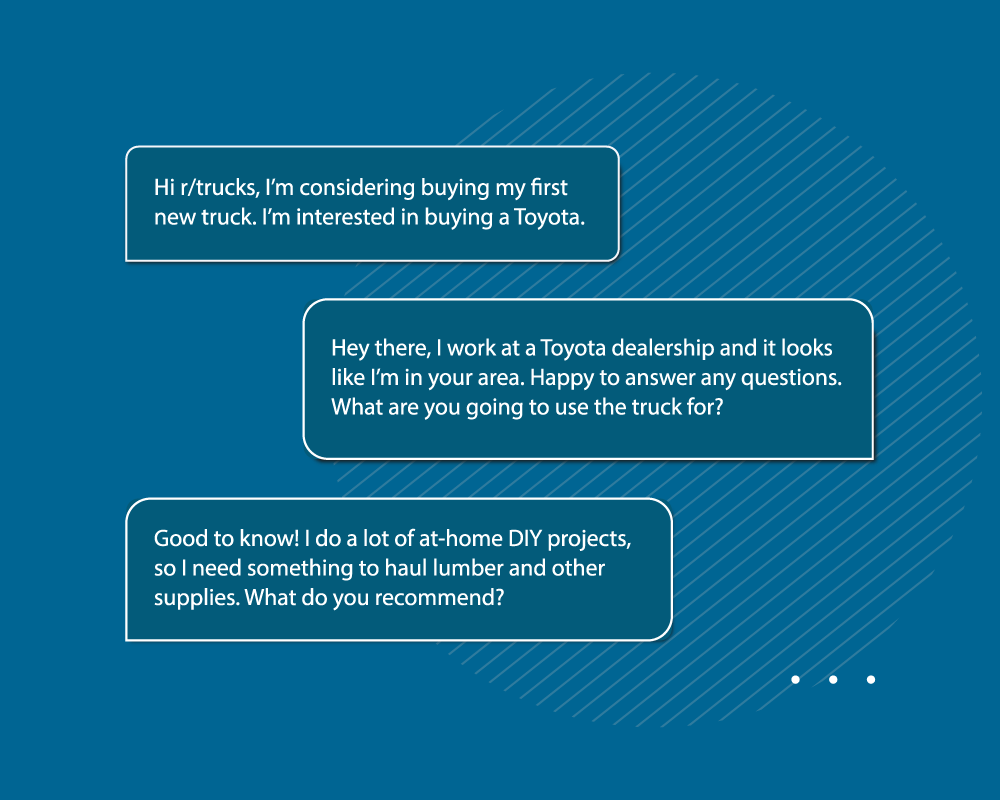U.S. auto sales dropped by 47% in April 2020, making this year one of the most challenging in the industry’s history. But as the market recovers, a new “truth” is becoming clear: Online consumer car-buying habits are here to stay, and automotive leaders must adapt to succeed.
In fact, digital media has been changing the car-buying experience for years. As early as 2013, consumers took only two trips to dealerships during their purchasing journey. Information on social media is now more relevant to the digital marketing mix, allowing brands to connect with consumers, deliver timely touchpoints, and win share of mind early in the decision making process. The onus is on dealerships to thrive in this new reality.
Fortunately, there is power in building online relationships with customers beyond what was possible before. There are more opportunities to engage and nurture those relationships than ever before as well. But how can automotive business leaders identify those moments successfully, and how can they determine the best courses of action when they do?
Moving Beyond Demographics to Intent-Based Engagement
For years, marketers have used traditional demographics as a means to identify possible future customers, even in digital environments. But recent data shows that marketers risk missing more than 70% of potential mobile shoppers when using demographic data alone. Demographics simply don’t tell the whole story — for that, automotive leaders need insights based on consumer intent.
Consumer intent is more powerful than demographic data simply because it allows marketers to reach the right people, at the right time. Automotive leaders should be engaging consumers when they ask an open-ended question on Facebook, for example, not simply because of their age or city of residence.
The goal, then, is to identify prospective customers with high intent at the right moments, then engage them in real time through their preferred channel online. Here’s a look at how consumer habits are changing and the opportunities for your team to address these changes successfully.
New Consumer Behaviors in Car Buying and Social Media
Today, 59% of car buyers spend time researching online before they buy. Social media has become an important part of that online journey — so much so that “for the automotive industry, it is a chance to target specific buyers based on their research habits,” Digital Marketing Institute reports.
Indeed, consumers are inclined to first turn to their smartphones when they want information or help. Today’s car buyers interact with 24 research touchpoints, for example — most of them online. This includes OEM and dealership sites, Adaptly reports, but also online reviews and social media.
These moments are chock full of valuable consumer intent, making them prime moments for engagement. They are moments of opportunity — not to market or advertise but to interact with consumers and build meaningful relationships that lead to real-world sales.
How Automotive Business Leaders Can Identify and Act on Consumer Intent Online
Under normal circumstances, the variety of social media channels and fleeting nature of real-time opportunities makes engaging consumers in this way impossible. But artificial intelligence (AI)-powered tools can help even small businesses find open-minded customers easily and effectively.
How do these tools work? They sift through social platforms to find these opportunities and then match people looking for a relevant solution to the business that can genuinely help. Marketers or subject-matter experts can then engage in direct conversations with consumers in real time.
With the right tools companies should not only spend less on marketing campaigns, they will also engage consumers at the right moment and offer their expertise, friendliness, and helpfulness for success.
Ultimately, consumers continue to prioritize aspects of the dealership experience, including test driving and engaging with real people face-to-face. What’s changed is that most modern consumers will already know the vehicle they want to purchase before visiting a dealership. With this in mind, even traditional dealerships can strike a balance between digital engagement and digital sales and provide the consumer with the experience they desire once in the dealership.
Building relationships online will revolutionize traditional sales processes and even introduce new opportunities for online-only sales. AI-driven tools maximize marketing costs and engagement rates, making consumer intent campaigns affordable no matter your company size.
Next Steps: Crossing the Finish Line With AI-Driven Engagement
Most automotive leaders are only scratching the surface when it comes to engaging consumers online. Online engagement has seemed impractical and expensive, especially considering the desire of salespeople to start building relationships once the customer is face-to-face in the dealership.
Today, AI-driven solutions that identify consumer intent are changing all that. Localizing consumer intent campaigns and striking value-focused conversations has never been easier. But it’s up to you to take the first steps.
FunnelAI is the leading solution for engaging consumers on social media based on real-time consumer intent. Contact one of our auto industry experts today to learn more about opportunities for your brand.









